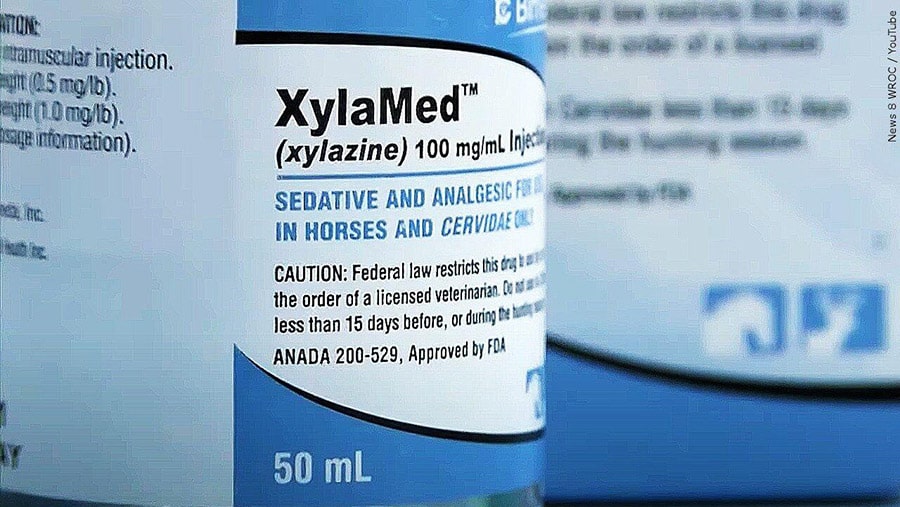Xylazine and Fentanyl: Xylazine Side Effects in Humans
The U.S. is already dealing with one of the biggest public health crisis in history: opioid addiction and overdose. Now, a new drug has hit the streets creating zombie-like characteristics in users. Xylazine is a powerful sedative the FDA has approved for veterinary use. It is also known as “tranq” or “tranq dope.” It is commonly used as a horse tranquilizer or as a painkiller for veterinary purposes. It is not safe for human use. This chemical substance has been recently found mixed into illicit drugs with fentanyl, methamphetamines, and other street drugs.
From 2020 to 2021, there was an increase in xylazine-related overdose deaths. Many of these deaths also involve the opioid fentanyl. Now the DEA is putting out a warning to all Americans alerting them on the rapid increase of trafficking fentanyl mixed with xylazine. It is still unclear who is mixing them and why they are doing it. However, xylazine side effects in humans are causing alarming health concerns to the public and the population of substance users.

According to the CDC, over 100,000 Americans between 2021 and 2022 died of a drug overdose. And 66% of those deaths involved synthetic opioids such as fentanyl. Recently, the presence of xylazine has been tested and found in illicit street drugs mixed in with fentanyl. The DEA has found that 23% of fentanyl powder and 7% of pills confiscated were confirmed to contain the substance xylazine. This polysubstance mix has been found in 48 out of 50 states and is making fentanyl even more deadly.
According to recent findings from the DEA, from 2020 to 2021, overdose deaths involving xylazine increased more than 1000% in the South, 750% in the West and an estimated 500% in the Midwest region of the U.S. Over the years, the substance would occasionally turn up in tested street drugs. However, its presence has skyrocketed over the past 12 months and growing at an extremely rapid rate. Experts say xylazine is a perfect “drug filler.” It is cheap and it is used to enhance the duration and effects of other drugs. This makes it more appealing to users and addicts.
For years, fentanyl has been driving the opioid and drug overdose crisis. Now with xylazine added to the mixture, there is a higher risk of overdose death. On top of that, it can make it much more difficult to revive or treat a person suffering from a fentanyl and xylazine overdose. Experts still don’t know how to reverse the effects of xylazine during an overdose because there is no reversal medication currently approved for human use.
Check Your Insurance Coverage for FREE
Find out if your insurance covers addiction treatment in minutes. We accept most insurance!
What is Xylazine?
Xylazine is a powerful sedative substance. It is a central nervous system depressant that causes drowsiness, slowed breathing and a dangerously slowed heart rate. It can also cause feelings of intense sedation and euphoria. Xylazine is an agonist and inhibits the release of norepinephrine and dopamine in the brain. This often leads to conditions such as anxiety, depression, sleep conditions and changes in blood pressure. Bayer Pharmaceutics first created the substance in 1962. It was initially researched and clinically trialed for potential human use as a sleep aid and anesthetic. However, due to its severe hypotension and dangerous central nervous system depressant effects, the research was terminated. In 1972, the drug was approved for veterinary use only.
Xylazine Side Effects in Humans
- Blurred vision
- Disorientation
- Staggering
- Hyperglycemia
- Intense sedation
- Difficulty breathing (respiratory depression)
- Dangerously low blood pressure
- Slowed heart rate
- Xylazine necrosis (severe skin lesions and rotting of the skin tissue)
- Severe withdrawal symptoms
- Coma
- Death
Reach out to Hotel California by the Sea
We specialize in treating addiction and other co-occurring disorders, such as PTSD. Our Admissions specialists are available to walk you through the best options for treating your addiction.
Response to the growing threat of Xylazine and Fentanyl
Because xylazine is not a drug under the Controlled Substance Act, it is easily accessible and much cheaper than other substances. This makes mixing them into street drugs more profitable. It is often knowingly and unknowingly added to other illicit drugs to enhance or prolong their effects. Unfortunately, its rapid growth is hindering State and Federal agencies’ ability to identify and track the spread of this new drug. Testing capabilities for this new drug are inconsistent across the country making it more difficult to keep the spread under control.
On April 12, 2023, the White House administration officially labeled this new threat the FAAX – Fentanyl Adulterated or Associated Xylazine. This would mark the first time in history that a presidential administration has considered a substance a serious threat to the country. The Combating Illicit Xylazine Act was recently introduced as bipartisan legislation that would call for the substance to be labeled as a Schedule III drug under the Controlled Substances Act. On top of that, the presidential administration is working rigorously to develop and implement an effective nationwide plan of action to tackle the issues surrounding xylazine-related overdose and death.
At Hotel California by the Sea, the substance use disorder program treats addictions to opioids and sedative drugs. Through multiple levels of care, patients can receive a comprehensive treatment plan targeting the concerns associated with their addiction. Detox, residential and outpatient programs provide intensive medication treatments and cognitive behavioral therapies individualized to each patient.
Evidence-based treatments such as MAT, CBT, EMDR and family therapy have been proven to produce lasting recovery results. As new drugs such as xylazine emerge into the market, Hotel California by the Sea is working diligently to create an effective treatment plan. By addressing the emotional, psychological and physical aspects of any addiction, treatment will result in longer-lasting sobriety and recovery.
References:
https://www.npr.org/2023/06/17/1178822364/tranq-xylazine-fentanyl-street-drug-heroin-overdose
https://www.dea.gov/alert/dea-reports-widespread-threat-fentanyl-mixed-xylazine
https://nida.nih.gov/research-topics/xylazine
https://www.deadiversion.usdoj.gov/
https://www.cnn.com/2023/04/12/health/fentanyl-xylazine-emerging-threat-us/index.html
